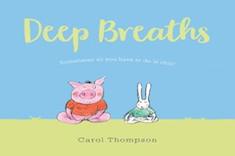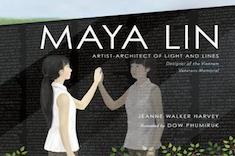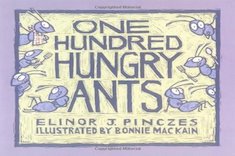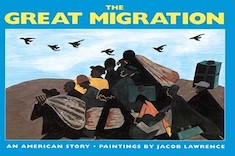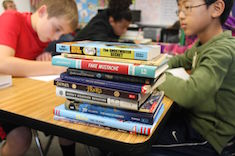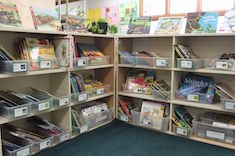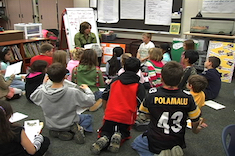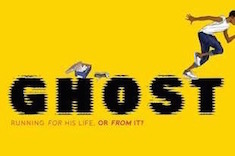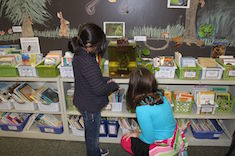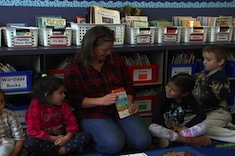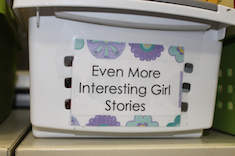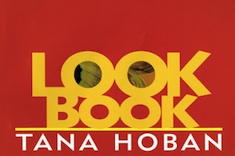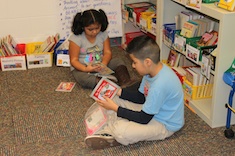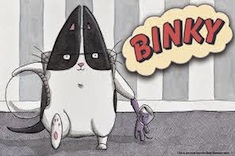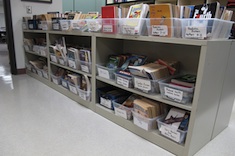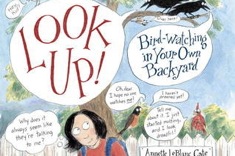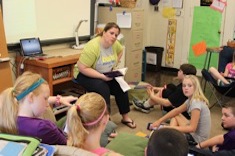Booklists
There are so many wonderful new children's and young adult books published each year -- and there is a lot of dreck out there too. We aim to be curators as we sort through, organize, and group books so that you can find just what you need. Whether it's mentor texts for a unit on persuasive writing, or just-right books for a fifth-grade English language learner, we've scoured lists of award winners, recommendations from colleagues, and the Kidlitsophere to come up with these lists.
Latest Content
Issues Overload
Shari Frost finds that the issues students may be dealing with in some children’s books can be overwhelming. She shares some of her favorite books for grappling with one troubling topic at a time.
Picture Books for Mental Wellness
Mandy Robek learns a lot about worry from her daughter, and discovers a treasure trove of picture books to promote mental wellness and help students cope with difficult emotions.
Meet Someone New Monday: Using Picture Book Biographies to Bring Marginalized Voices into the Classroom
Melissa Quimby creates “Meet Someone New Monday” to inspire students with picture book biographies of little-known artists, activists, and citizens who accomplish remarkable feats.
Letting Students Organize Informational Books
Mandy Robek is a little nervous about setting her students loose to organize informational texts, but she couldn’t be more pleased by what they learn in the process.
Reassuring Worried Children with Picture Books
Mandy Robek learns a lot about worry from her daughter, and at the same time discovers a treasure trove of children’s books to help students overcome worries.
Reading and Writing for the 100th Day of School
The 100th day of school has become an opportunity for classroom and schoolwide celebrations. Shari Frost provides many resources to ensure reading and writing are front and center on this special day.
Raising Student Voices: Mentor Texts
Helping students find and raise their voices so that they can someday change the world is one of the most important things we do. Cathy Mere shares some of her favorite mentor texts for this essential work.
Detour Texts
Clare Landrigan and Tammy Mulligan explain the concept of “detour texts”—picture books to use as mentor texts in the intermediate grades to illustrate complex literary elements. They also share three of their favorite new children’s books to use as detours.
Expanding Black History Month Reading
A heavy sigh from a student is a cue to Shari Frost that he has heard the same Martin Luther King picture book biography one too many times in February. She shares her top picture book picks for expanding children’s awareness of black history all year long.
Picture Book Biographies
Stella Villalba shares some of her favorite new picture book biographies for bringing history to life for young learners, with a focus on perseverance.
Refugees: A Children’s Booklist
There is probably no population more misunderstood or vilified than refugees. Stella Villalba shares a booklist to help young students understand the refugee's plight and experiences.
Comics and Graphic Novels for Tweens
Comic books and graphic novels are genres tweens adore, but teachers sometimes struggle to embrace. Ruth Shagoury creates a booklist with engaging books in the genre any teacher would enjoy.
Books on a Budget
There are scores of new children’s books that continually tempt teachers. But how do you stock your classroom library with a limited budget? Shari Frost shares proven strategies.
Mentor Texts for Letter Writing
Clare Landrigan and Tammy Mulligan share some of their favorite mentor texts for a unit on letter writing.
More Nonfiction Read Alouds
Franki Sibberson shares strategies for incorporating more nonfiction into read-aloud times throughout the day.
Great Books for African American Boys
Shari Frost deals with the failure of a classic read-aloud text to reach young African American boys by finding more engaging books for them.
The Benefits of #bookaday
Franki Sibberson finds the investment of five to seven minutes a day for #bookaday with her third graders is truly time well spent.
Increasing Read Alouds in the Primary Grades
Bitsy Parks describes her process over the years in increasing both the quality and quantity of read alouds in her first-grade classroom.
No More Strong Girls?
Are there ways for girls in literature to be heroic without fighting? Shari Frost asks herself this question in compiling her latest booklist.
Playful Texts for Beginning Readers
Shari Frost uses playful texts to increase interest and stamina in emergent readers. She shares many of her favorites in this booklist.
Books That Mirror the Children in Our Classrooms
Stella Villalba shares some of her favorite children’s books that mirror the home cultures of English language learners.
Graphic Novels for Beginning Readers
If you are looking to increase the quantity and quality of graphic novels for your learners in your classroom library, Shari Frost has a new booklist to get you started.
Culturally Responsive Texts
Katrina Edwards is horrified when a student response reveals cultural gaps in her first-grade classroom library. She researches possibilities for expanding the diversity of texts, and shares an annotated bibliography to download linking different cultures and curricular possibilities.
Adjusting the Classroom Library for Student Needs
Mandy Robek realizes her classroom library isn’t working for her second graders, in part because many of the books are still too difficult for students early in the year. She explains her process of sorting and stowing books for later use.
Teaching Inference Through Picture Books
Katherine Sokolowski explains why picture books are useful for teaching inference to intermediate students, and shares some of her favorites.
Little Levels, Big Thinking
Katie DiCesare moves beyond levels to consider her first-grade readers’ needs.
Reorganizing Primary Information Texts
Katie DiCesare thinks about the needs of her first-grade students, and spends some time reorganizing primary information texts, considering both physical texts for the library and online resources.
Nonfiction Books with More Than One Entry Point
Franki Sibberson shares some of her favorite nonfiction books with more than one entry point.
A Booklist for Grandparents Day
Sarah Klim presents a booklist for Grandparents Day, with many suggestions for read alouds to promote the September event.
Read Alouds as “Third Things”
Katherine Sokolowski uses read alouds early in the year to help students reflect on how to be kind and thoughtful members of a classroom community.
Browse Content By
Type
Category
- Assessment Tools
- Big Fresh Archives
- Booklists
- Choice Numeracy
- Classroom Design
- Common Core
- Community Building
- Conferring
- Content Literacy
- Digital Literacy
- English Language Learners
- Equity
- Family Relations
- Free Samples
- Guiding Groups
- Leadership
- Literacy Coaches
- Mentor Texts
- Minilessons
- New Teacher Mentors
- Podcasts
- Poetry
- Quote Collections
- Reading Strategies
- Self Care
- Struggling and Striving Learners
- Talking and Listening
- Teacher Study Groups
- Teaching Reading
- Teaching Writing
- Word Study and Vocabulary
Author
- Melissa Quimby
- Nawal Qarooni
- Gwen Blumberg
- Julie Cox
- The Lead Learners
- Hannah Tills
- Josie Stewart
- Ruth Metcalfe
- Mallory Messenger
- Becca Burk
- Jodie Bailey
- Vivian Chen
- Mary Brower
- Tiffany Abbott Fuller
- Stephanie Affinito
- Ruth Ayres
- Leigh Anne Eck
- Heather Fisher
- Shari Frost
- Julie Johnson
- Suzy Kaback
- Gigi McAllister
- Shirl McPhillips
- Melanie Meehan
- Cathy Mere
- Debbie Miller
- Tara Barnett and Kate Mills
- Tammy Mulligan
- Dana Murphy
- Bitsy Parks
- David Pittman
- Brenda Power
- Heather Rader
- Matt Renwick
- Mandy Robek
- Christy Rush-Levine
- Gretchen Schroeder
- Jen Schwanke
- Brian Sepe
- Katherine Sokolowski
- Stella Villalba
- Jennifer Vincent
Grade Level
Choice Literacy Membership
Articles
Get full access to all Choice Literacy article content
Videos
Get full access to all Choice Literacy video content
Courses
Access Choice Literacy course curriculum and training


